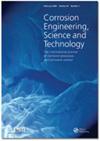HSO3−和交流电对CoCrFeNi HEA在模拟海洋环境中腐蚀行为和机理的影响
IF 1.5
4区 材料科学
Q4 MATERIALS SCIENCE, MULTIDISCIPLINARY
Corrosion Engineering, Science and Technology
Pub Date : 2023-03-18
DOI:10.1080/1478422X.2023.2190443
引用次数: 0
摘要
摘要系统地研究了CoCrFeNi HEA在含有不同浓度NaHSO3的3.5wt.%NaCl溶液中的交流腐蚀行为和机理。结果表明,HSO3−的存在增加了HEA表面钝化膜内的缺陷密度。随着HSO3−浓度的增加,钝化区变窄,Ep负移,ip增加,表明HEA的耐腐蚀性减弱。当HSO3−浓度增加到0.1M时,出现了一个明显的过渡区,表明浓度的增加降低了HEA的钝化性,并且随着iAC的增加,其腐蚀行为从典型的钝化特性转变为活化状态。外加AC促进了亚稳点蚀的形核,这表明随着iAC的增强,平均点蚀数密度(Navg)从5 mm−2显著增加到17 mm−2。图形摘要本文章由计算机程序翻译,如有差异,请以英文原文为准。
Effect of HSO3 − and alternating current on corrosion behaviour and mechanism of CoCrFeNi HEA in a simulated marine environment
ABSTRACT The corrosion behavior and mechanism of CoCrFeNi HEA under AC application were systematically studied in 3.5 wt.% NaCl solution containing different concentrations of NaHSO3. The results showed that the existence of HSO3 − increased the defect density within the passivation film on the surface of the HEA. With the increase of HSO3 − concentration, the passivation zone became narrow, Ep shifted negatively, and ip increased, which indicated that the corrosion resistance of the HEA was weakened. When the HSO3 − concentration increased to 0.1 M, a clear transition zone appeared, indicating that the increase in concentration reduced the passivity of the HEA, and its corrosion behavior changed from the typical passivation characteristic to the activation state with increasing iAC. The imposed AC promoted the nucleation of metastable pitting, which was indicated by a remarkable increase in the average pitting number density (Navg) from 5 to 17 mm−2 with the enhancement of iAC. GRAPHICAL ABSTRACT
求助全文
通过发布文献求助,成功后即可免费获取论文全文。
去求助
来源期刊

Corrosion Engineering, Science and Technology
工程技术-材料科学:综合
CiteScore
3.20
自引率
5.60%
发文量
58
审稿时长
3.4 months
期刊介绍:
Corrosion Engineering, Science and Technology provides broad international coverage of research and practice in corrosion processes and corrosion control. Peer-reviewed contributions address all aspects of corrosion engineering and corrosion science; there is strong emphasis on effective design and materials selection to combat corrosion and the journal carries failure case studies to further knowledge in these areas.
 求助内容:
求助内容: 应助结果提醒方式:
应助结果提醒方式:


